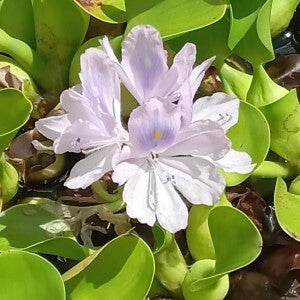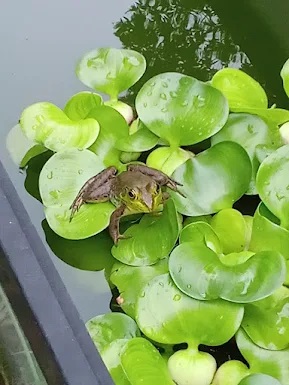Uses: Fodder, Edible, Textile, Biofuel Native To: South America, primarily Brazil
Known as the Terror of Bengal due to its prolific nature.
Water hyacinth is a beloved plant at Eat The Sand, because it grows quickly and is an extremely nutritious food source. It is well received by the rabbits and the ducks, and during the warmer months it makes up a large part of their diet.
Water hyacinth is a prolific reproducer. It rivals the rabbits in terms of growth, as it has been known to double in size in as little as three weeks if the growing conditions are favorable. The floating plant will make daughter plants by way of a stolen, not all that differently from the houseplant known as the spider lily. These new plants will grow their own root systems quickly and then break off from the parent during a storm. They also make beautiful purple flowers which can make seeds, which is why water hyacinth should not be grown near any bodies of water in Florida. One only has to visit Lettuce Lake Park in Hillsborough County to see water hyacinth and water lettuce taking over the place.
So if you’re thinking that water hyacinth might be a great plant for your homestead and you have no naturally occurring water near you or you have regular freezes during the winter, let me tell you that water hyacinth is awesome! It doesn’t have the calcium oxalate crystals that water lettuce has, so is safe to give to animals, and it tastes fantastic. It is high in protein (50%), carbohydrates (36.6%), fiber (17.1%) and also the carotene vitamins such as A, B1, and B2. It has to be cooked for safety as it grows in fresh water. Here at the Eat The Sand it grows in manure water.
To produce water hyacinth on large enough quantities to make it useful on the homestead, you will need at least one but preferably more than one pool of water with a large surface area. We recommend using kid pools that are buried down into the ground for water hyacinth production. The pools will need to be topped off with water and occasional nutrients added to promote good growth. They will need to be located in full sun or part sun, but can still grow in deep shade if slowly. Inexpensive gold fish from the pet store should be added to any larger pools as they will eat mosquitos and make plant fertilizer. Smaller pools will need BT mosquito dunks available in the pond section of most stores or online here at Eat The Sand.
Water hyacinth do well when water temperatures are between 65 F and 90 F. Outside those temperatures the plants will begon to die off. It is recommended for northern gardeners to overwinter the hyacinth indoors in a fish tank or buy new stock in the spring.
Aside from its extreme edibility, water hyacinth makes a great mulch layer or compost additive. It has nitrogen fixing bacteria around its roots in the water, and it contains nitrogen rivaling some land based plants like comfrey and alfalfa. Here is an excellent video describing super easy water hyacinth compost making.

If you are interested in trying water hyacinth for your homestead, we have some for sale here.
